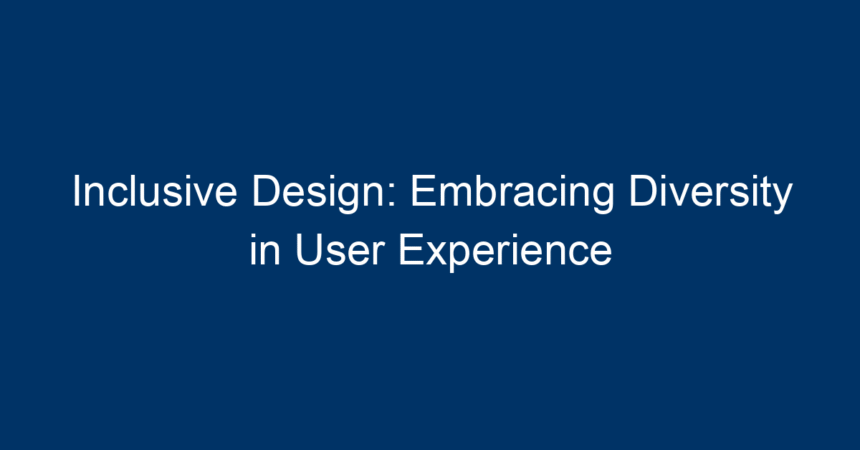In a world that thrives on diversity, the way we design products, services, and experiences should reflect this reality. Inclusive design is not just a trend; it’s a fundamental approach that recognizes and values differences among users. By embracing diversity, we can create user experiences that are more effective, accessible, and meaningful to a broader audience. This article delves into the principles of inclusive design, its importance, and actionable strategies to implement it effectively.
What is Inclusive Design?
Inclusive design is a design philosophy that aims to create products and services accessible to as many people as possible, regardless of their backgrounds, abilities, or situations. This methodology recognizes that every user is unique and may have specific needs that should be prioritized during the design process.
Key Principles of Inclusive Design
-
Recognize Diversity:
- Acknowledging the wide range of human differences, including but not limited to age, gender, ethnicity, ability, and socio-economic status is crucial. Inclusive design starts with the understanding that users have different needs and preferences.
-
Empower Users:
- The goal of inclusive design is to create solutions that empower users rather than hinder them. Tools and experiences should provide users with options that cater to their needs while respecting their individuality.
- Iterative Process:
- Inclusive design is an ongoing journey. It requires a commitment to refining and improving designs based on feedback from diverse users. Prototyping, testing, and revising are integral to creating truly inclusive products.
The Importance of Inclusive Design
Inclusive design is not merely a moral imperative; it has significant business implications as well. Here are some reasons why embracing diversity in user experience matters:
1. Expanding User Base
When you prioritize inclusive design, you open your products and services to a larger audience. A well-designed experience appeals to a diverse user base, potentially increasing your market share.
2. Enhanced User Satisfaction
Creating products that consider various user needs leads to higher satisfaction rates. Users are more likely to engage with and recommend products that are tailored to meet their unique requirements.
3. Compliance and Accessibility
Many regions have regulations that require businesses to adhere to accessibility standards. Inclusive design helps you comply with these laws while fostering a culture of inclusivity.
4. Innovation and Differentiation
When you incorporate diverse perspectives into the design process, you are more likely to innovate. This approach encourages creative problem-solving, leading to distinctive products that stand out in the marketplace.
Implementing Inclusive Design: Strategies and Best Practices
Implementing inclusive design principles requires intentional action. Here are actionable strategies to help you get started:
1. Conduct User Research
Understanding your users is at the heart of inclusive design. Conduct surveys, interviews, and focus groups that include participants from a variety of backgrounds to gather insights about their needs and preferences. Pay special attention to underrepresented groups to ensure their voices are heard.
2. Embrace Multi-Sensory Design
Consider the different ways people perceive information. Incorporate audio, visual, and tactile elements into your designs. For instance, using contrasting colors for visual elements helps users with low vision, while audio descriptions assist those with visual impairments.
3. Promote Flexible Interactions
Design interactions that allow users to engage with products in various ways. For example, offering keyboard shortcuts in addition to mouse interactions caters to users with motor impairments while providing options for voice control.
4. Build Accessibility Into Your Design Process
Make accessibility a core aspect of your design workflow. Regularly evaluate your designs against accessibility standards (such as WCAG) to ensure they’re usable for all. Utilizing automated testing tools can aid in identifying accessibility issues early on.
5. Include Diverse Teams
Diversity in your design team can lead to richer perspectives and more comprehensive solutions. Encourage collaboration among individuals with different backgrounds and experiences to foster creativity and innovation in your designs.
6. Test with Real Users
Prototyping and testing with diverse user groups as early as possible will help identify potential barriers and usability issues. Watching users interact with your designs can provide invaluable insights that inform your final product.
Case Studies of Successful Inclusive Design
To illustrate the benefits of inclusive design, let’s look at a few successful examples:
1. Apple’s VoiceOver Feature
Apple’s commitment to inclusive design is evident in its VoiceOver feature, which enables users with visual impairments to interact with their devices. By providing audio descriptions and gestures, Apple has set a benchmark in accessibility.
2. Microsoft’s Inclusive Technology
Microsoft has integrated inclusive design principles into its product development, particularly with tools like the Xbox Adaptive Controller. Designed for gamers with disabilities, this controller allows for customizable configurations, empowering users to enjoy gaming experiences tailored to their needs.
3. Google’s Accessibility Features
Google implements a variety of accessibility features across its platforms, including text-to-speech capabilities in Google Docs and adjustable font sizes in Android. These features cater to a wide range of users, ensuring everyone can access information and services.
The Future of Inclusive Design
As the world becomes increasingly interconnected, the need for inclusive design will only grow. Advances in technology provide new opportunities for creating accessible experiences. Artificial intelligence, for example, can help personalize user experiences based on individual needs, while virtual reality offers immersive training environments for diverse audiences.
Embracing inclusive design is more than a trend; it’s a commitment to creating a world where everyone can participate equally. As designers and businesses, we have a responsibility to champion diversity and ensure that our products empower all users.
Conclusion: Actionable Insights for Practitioners
- Engage with Users: Prioritize user research and continuously seek feedback from diverse user groups.
- Incorporate Accessibility: Invest in training your team on accessibility standards to embed these principles into your design process.
- Collaborate and Innovate: Build a diverse design team and encourage collaboration to inspire innovative solutions.
- Test and Refine: Regularly test your designs with real users to identify areas for improvement and refine accordingly.
By embracing the principles of inclusive design, we can create experiences that resonate with diverse audiences, foster innovation, and ultimately drive success for our businesses. Together, let’s build a future that celebrates diversity and empowers everyone, ensuring no one is left behind.




